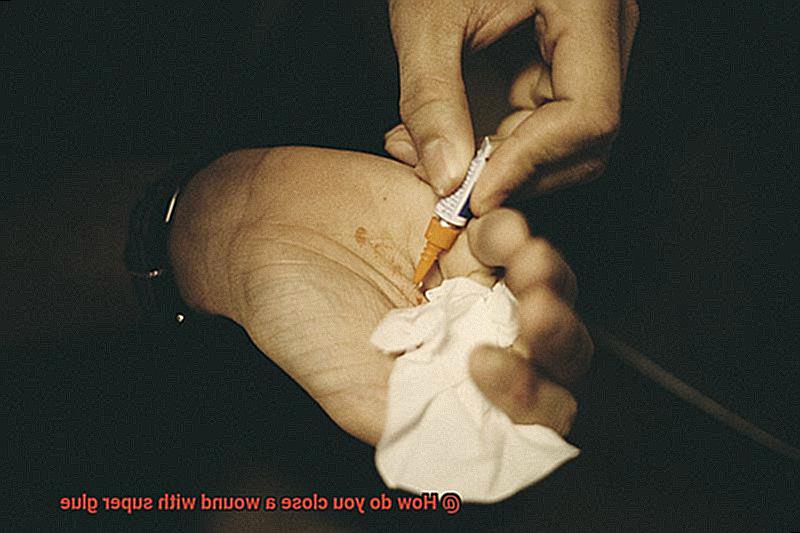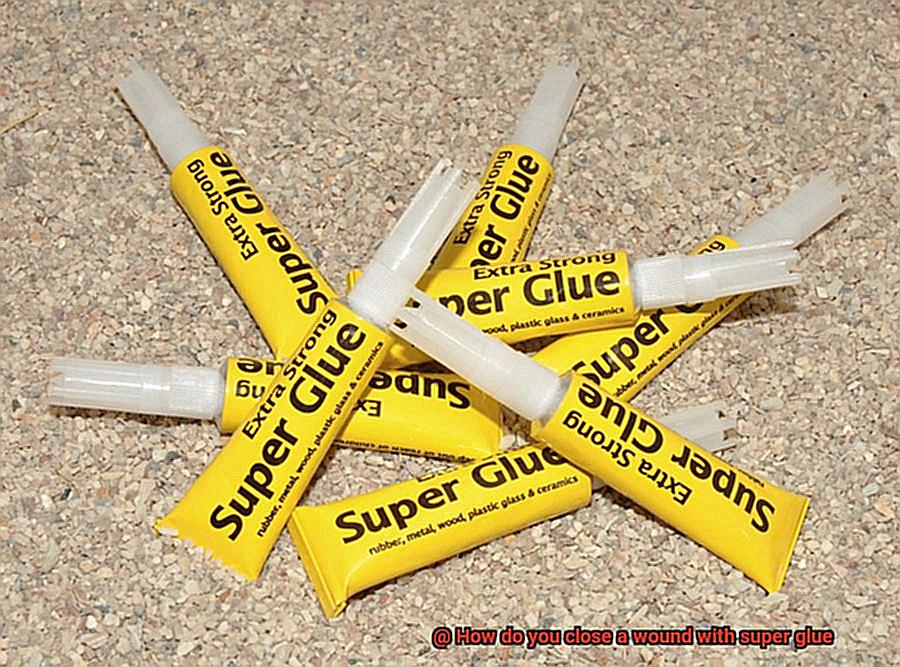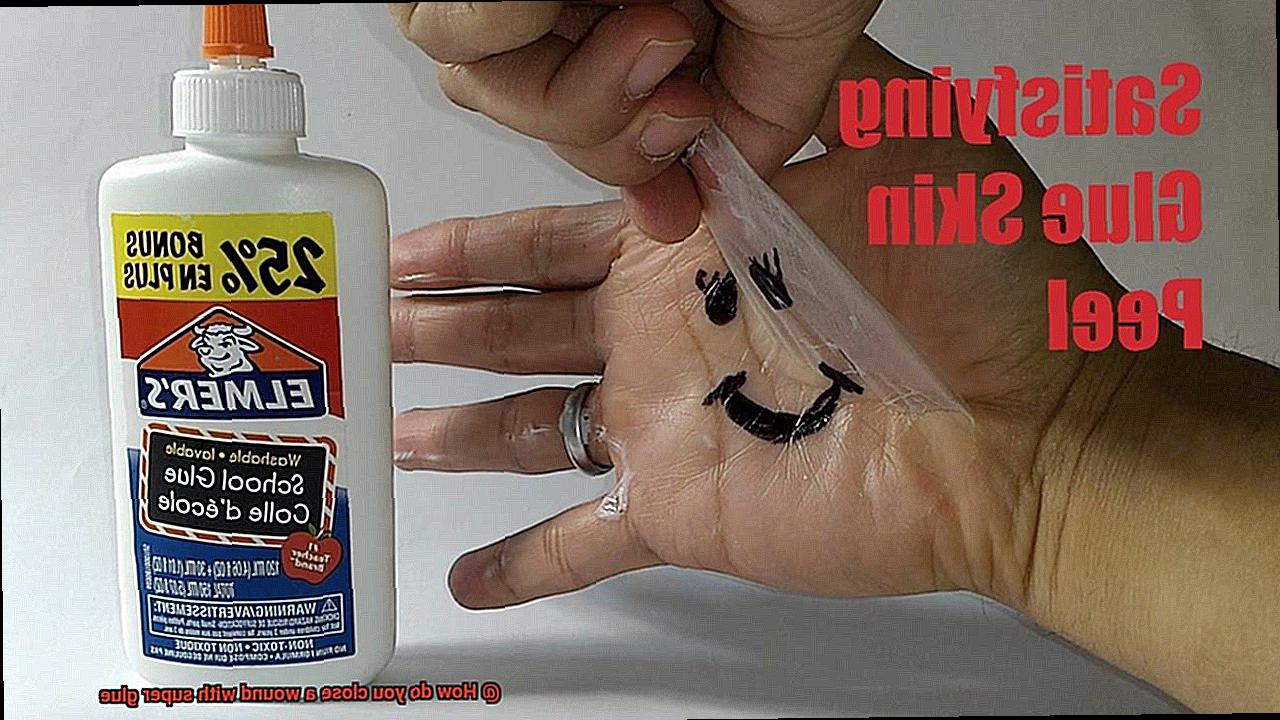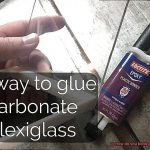We’ve all been there – a nasty cut or scrape that needs closing up ASAP, but no stitches or bandages in sight. Well, fear not. Did you know that super glue can come to the rescue? Yep, you heard it right. That trusty adhesive we use for fixing broken stuff around the house can also work wonders for sealing up wounds. But hold on tight, because we’re about to dive into the nitty-gritty of how to safely and effectively close wounds with super glue. So, grab your first aid kit (or just your glue) and let’s get started.
Preparing the Wound: Cleaning and Drying
Contents
- 1 Preparing the Wound: Cleaning and Drying
- 2 Applying the Super Glue: Using a Sterile Applicator or Cotton Swab
- 3 The Adhesive’s Bonding Process: Creating a Protective Barrier
- 4 When to Avoid Using Super Glue for Wound Closure
- 5 Caring for the Wound After Application: Keeping it Clean and Dry
- 6 Potential Complications of Using Super Glue on a Wound
- 7 Alternatives to Using Super Glue for Wound Closure
- 8 Conclusion
Closing wounds with super glue has gained popularity as a DIY method for minor cuts and scrapes. However, achieving optimal results requires more than just applying the adhesive. Thoroughly cleaning and drying the wound beforehand play a vital role in preventing infection and ensuring successful wound closure. In this article, we explore the importance of these preparatory steps and provide valuable insights for a safe and effective wound closure experience.
Step 1: Cleaning the Wound
Prioritizing cleanliness is paramount before embarking on any wound closure technique. Start by washing your hands meticulously with soap and water, eliminating any potential risks of introducing harmful bacteria to the wound. Once your hands are impeccably clean, proceed to cleanse the wound itself.
Delicately rinse the wound under cool running water, effectively banishing lurking dirt, debris, or bacteria from its surface. Avoid hot water, which can inflict further tissue damage or discomfort. If running water is unavailable, opt for a sterile saline or antiseptic solution recommended by your healthcare provider.
Step 2: Drying the Wound
After a refreshing rinse, it’s time to dry the wound with utmost care and thoroughness. Gently pat the wound dry using a clean, sterile gauze pad or a soft cloth. Refrain from vigorously rubbing the wound, as this can cause additional harm or introduce new contaminants.
Remember to dry not only the wound but also its surrounding area. By ensuring a pristine and dry surface, you create an ideal environment for optimal adhesion of the super glue.
Step 3: Assessing the Wound
Before proceeding with super glue closure, take a moment to assess the size and depth of the wound. Super glue is best suited for small cuts, scrapes, and lacerations that don’t necessitate medical attention. For larger or deeper wounds, it is prudent to have them evaluated by a healthcare professional.
Furthermore, remain vigilant for signs of infection, such as redness, swelling, pus, or excessive pain. If any of these symptoms manifest, seeking immediate medical assistance becomes imperative.
Conclusion:

Closing wounds with super glue can be a convenient and effective method in certain situations. However, proper wound preparation through meticulous cleaning and thorough drying is essential for success. Ensure a thorough cleanse of the wound using cool running water or a recommended sterile solution. Gently pat the wound dry with a clean, sterile gauze pad or cloth. Assess the size and depth of the wound to determine its suitability for self-treatment.
Applying the Super Glue: Using a Sterile Applicator or Cotton Swab
Well, fret no more. In this article, we will guide you through the proper steps for applying super glue using a sterile applicator or cotton swab. But before we get down to business, let’s understand the importance of cleaning the wound thoroughly.
Step 1: Cleanse Like a Pro
Before you bust out that trusty bottle of super glue, make sure your wound is squeaky clean. Give it a gentle wash with mild soap and water, using a clean cloth or your fingers. Pat it dry with a clean towel or let it air-dry completely. Remember, cleanliness is the key to preventing infection and promoting optimal healing.
Step 2: Choose Your Weapon – Sterile Applicator or Cotton Swab?
Now that your wound is in pristine condition, it’s time to select your tool for applying the super glue. A sterile applicator is your best bet as it minimizes the risk of introducing bacteria into the wound. But fear not, if you don’t have one on hand, a new and clean cotton swab can do the trick. Just remember to avoid any potential contaminants.
Step 3: Apply with Finesse
Gently squeeze the sides of the wound together using your fingers or sterile tweezers to align the edges. Dip your chosen tool into the super glue, making sure not to go overboard and release too much glue. Remember, less is more.
Starting at one end of the wound, glide along its length using light and smooth strokes. Apply a thin layer of super glue, ensuring even coverage across the entire wound. This thin layer will work wonders in closing up the wound without causing irritation or allergic reactions.
Step 4: Bonding Time – Hold and Set
Once the super glue is applied, hold the edges of the wound together for about a minute. This crucial step allows the glue to bond and set. Gently release your hold, avoiding any strain on the wound, and give it at least 10 minutes to fully dry and set.
Step 5: Maintain Cleanliness and Protect
During the healing process, it’s paramount to keep the glued wound clean and dry. Avoid submerging it in water or exposing it to excessive moisture. If the wound is in an area prone to movement or rubbing, consider covering it with a sterile adhesive strip or a small bandage for added protection.
The Adhesive’s Bonding Process: Creating a Protective Barrier
Prepare to embark on a fascinating journey into the world of adhesive bonding and its remarkable ability to create a protective barrier when used to close wounds. Get ready for an adventure filled with sticky wonders.
Imagine this scenario: you accidentally slice your finger while slicing vegetables or tinkering with DIY projects. Ouch. But fear not, because super glue, also known as cyanoacrylate adhesive, may come to the rescue. This versatile adhesive is often employed in emergency situations where immediate wound closure is crucial.
When you apply super glue to your wound, it undergoes a rapid transformation known as polymerization. This is when the magic truly happens. The molecules in the glue react with the moisture on your skin, forming long chains and establishing a robust bond. It’s like an army of glue soldiers marching in to save the day.
But there’s even more to it. Super glue isn’t just about sticking things together – it also creates a protective barrier. Once it bonds with your skin, it forms a thin layer that acts as an impenetrable shield against unwanted intruders. No, we’re not talking about nosy neighbors; we mean bacteria, dirt, and other pesky pathogens that could cause an infection.
And that’s not all. Our trusty adhesive companion also aids in controlling bleeding. By sealing off the edges of your cut or laceration, super glue works its magic and promotes clotting. It’s like having a tiny superhero sidekick that stops bleeding in its tracks.
However, before you start reaching for the super glue for every scrape and scratch, remember that it isn’t suitable for all wounds. Deep or heavily bleeding wounds, jagged edges, and puncture wounds may require medical attention and professional suturing techniques. Always ensure thorough cleaning of your wound before applying super glue to ensure proper healing and prevent any unwanted surprises.
In summary, the bonding process of super glue is akin to a superhero power that closes wounds and creates a protective barrier. Its swift polymerization and strong bond formation enable quick wound closure in emergency situations. The protective layer it creates acts as a fortress, keeping harmful germs at bay and reducing the risk of infection. Nevertheless, remember to use your adhesive powers judiciously and seek medical assistance when necessary.
When to Avoid Using Super Glue for Wound Closure
When it comes to wound closure, super glue can seem like a superhero with its quick and strong bonding abilities. But just like any superhero, there are situations where super glue should not be relied upon. So, before you reach for that little tube of adhesive, let’s take a closer look at when it’s best to avoid using super glue for wound closure.
Firstly, deep wounds or wounds with significant tissue loss should not be closed with super glue. These types of wounds require proper medical evaluation and treatment. Stitches or other suturing techniques are often necessary to ensure proper healing.
Secondly, super glue should not be used on infected wounds or wounds at risk of infection. Before applying any adhesive, make sure the wound is clean and free from bacteria. Super glue can trap bacteria inside the wound, leading to delayed healing and potential complications.
In addition, wounds located in high movement areas such as joints or areas prone to stretching should not be closed with super glue. The excessive strain on the adhesive may cause it to fail, resulting in wound reopening or delayed healing.
Furthermore, heavily bleeding wounds should not be closed with super glue. In cases of severe bleeding, it’s essential to seek immediate medical attention rather than attempting to close the wound with super glue. Medical professionals have the expertise and tools to address these situations effectively.
If you have a known allergy or sensitivity to cyanoacrylate adhesive, it’s best to opt for alternative wound closure methods. Allergic reactions can range from mild irritation to severe allergic dermatitis, so it’s important to avoid using super glue if you have a known allergy.
Lastly, wounds with jagged edges or requiring precise alignment for proper healing should not be closed with super glue. The adhesive may not provide the required accuracy, which can hinder the healing process. Seek medical attention for wounds that need accurate alignment or have jagged edges.
Caring for the Wound After Application: Keeping it Clean and Dry
You’ve taken the bold step of closing your wound with super glue. Now, the question arises: how do you properly care for it? Fear not, for we have all the answers you seek. After applying super glue to close a wound, it is of utmost importance to take the necessary steps to keep it clean and dry. This not only promotes proper healing but also reduces the risk of infection. Allow us to guide you through this essential process with some best practices:
- Cleanse gently: Begin by delicately washing the area surrounding the wound with mild soap and water. Steer clear of scrubbing the wound or employing harsh cleansers, as these actions can disrupt the healing process. Instead, treat the area with tenderness and care. Once washed, gently pat it dry with a clean towel or allow it to air dry naturally.
- Keep it dry: Moisture is the archenemy of super glue’s adhesive properties and can also heighten the risk of infection. To combat this, avoid activities that cause excessive sweating or create moisture buildup, such as intense physical exercise or prolonged exposure to water. In the event that the wound does become wet, lightly pat it dry with a clean towel. Remember, under no circumstances should you rub or apply pressure to the area.
- Waterproof bandage or dressing: Depending on the location of the wound and your daily activities, covering it with a waterproof bandage or dressing may be necessary. This protective layer acts as a shield against moisture during showers or any activity where the wound might be exposed to water.
- Avoid picking or scratching: The temptation to pick at or scratch a healing wound can be overwhelming at times. However, it is vital to resist this urge as doing so introduces bacteria and increases the risk of infection. If you experience any itching sensation, employ a clean, soft cloth to lightly pat the area instead.
- Watch for signs of infection: Regularly monitor the wound for any signs of infection, such as heightened redness, swelling, pain, or the presence of pus. Should any of these symptoms manifest, seek medical attention promptly. Your well-being is paramount, and professional assistance is crucial in such cases.
- Follow healthcare provider’s instructions: Lastly, be sure to adhere to any specific instructions provided by your healthcare provider regarding wound care. They possess valuable knowledge and might offer additional recommendations based on the location and severity of the injury.

Potential Complications of Using Super Glue on a Wound
We’ve all faced that dreaded moment – a cut or gash in need of immediate attention, but no first aid kit in sight. In times of desperation, some may consider reaching for the quick fix of super glue. However, this seemingly convenient solution can lead to a host of potential complications and risks that you need to be aware of. In this article, we will explore the dangers associated with using super glue as a wound treatment.

The Risk of Infection:
Using super glue on wounds introduces a significant risk of infection. Research has shown that this adhesive is not sterile and can introduce harmful bacteria into the wound, increasing the chances of developing an infection. A study published in the Journal of Emergency Medicine found that wounds sealed with super glue had a significantly higher infection rate compared to those treated with traditional wound closure methods.
Toxicity and Allergic Reactions:
Super glue contains chemicals that are toxic to living tissue. When applied to wounds, it can cause cell damage and irritation. In some cases, individuals may experience allergic reactions to the chemicals in super glue, leading to further complications and discomfort.
Impaired Wound Healing:
Super glue forms a rigid, waterproof seal over wounds, which impedes proper healing. This can result in delayed wound closure and the formation of unsightly scar tissue. Proper wound healing requires air circulation and natural drainage, both of which are hindered by the impermeable barrier created by super glue.
Difficult Medical Assessment:
Seeking medical attention for a wound involves visual inspection and thorough cleaning to assess the extent of injury and identify any underlying damage. However, the presence of super glue can make it challenging for healthcare professionals to accurately evaluate the wound. This may lead to misdiagnosis and delayed or inappropriate treatment.
Alternatives to Using Super Glue for Wound Closure
Imagine accidentally slicing your finger while chopping vegetables, and you’re in need of a quick fix. While super glue might seem like an easy solution, it’s crucial to explore alternatives that are not only safer but more effective for wound closure. In this blog post, we’ll delve into five alternatives that can come to your rescue when it comes to treating minor injuries.
Adhesive Strips or Bandages:
Designed specifically for wound closure, adhesive strips provide a secure and sterile option for small cuts or lacerations. These strips pull the edges of the wound together, promoting healing and reducing scarring. They are convenient to apply and remove.
Medical-Grade Skin Adhesives:
Widely used in surgical settings, medical-grade skin adhesives offer a strong bond, sterility, and antimicrobial properties to prevent infection. Applied using a special applicator or brush, these adhesives effectively close small to moderate-sized wounds.
Sutures (Stitches):
For larger and deeper wounds requiring precise alignment and tension control during the healing process, sutures are the go-to option. They provide superior wound approximation compared to super glue and allow for better fluid drainage. Sutures are typically placed by healthcare professionals and may require removal after a specified period.
Steri-Strips (Butterfly Closures):
Ideal for small cuts or lacerations that don’t require sutures, Steri-strips – also known as butterfly closures – pull the edges of the wound together. These adhesive strips can be an effective alternative to super glue in certain situations.
Medical Tape:
In some cases, medical tape can be used not only to secure dressings or bandages but also to help close wounds. By applying tension to the wound edges, medical tape promotes healing and reduces scarring.
F46t731hTmg” >
Conclusion
In conclusion, utilizing super glue to close wounds can prove to be a convenient and highly effective method in certain circumstances. However, achieving successful results hinges upon meticulous wound preparation, emphasizing the utmost importance of thorough cleaning and complete drying. To begin, cleanse the wound diligently using cool running water or a recommended sterile solution. Next, gently pat it dry with a clean, sterile gauze pad or cloth. It is crucial to carefully evaluate the wound’s size and depth to determine if self-treatment is appropriate.
When it comes time to apply the super glue, employ a sterile applicator or cotton swab for precision as you delicately spread a thin layer of glue along the entire length of the wound. Hold the edges together for approximately one minute to allow for proper bonding and setting of the adhesive. Safeguard the glued wound by maintaining its cleanliness and avoiding excessive moisture or submersion in water. If necessary, consider protecting it further with a waterproof bandage or dressing.
It is essential to note that not all wounds are suitable candidates for closure with super glue. Deep wounds, infected wounds, wounds located in highly mobile areas, heavily bleeding wounds, allergies to cyanoacrylate adhesive, and wounds featuring jagged edges or requiring precise alignment should not be closed using this method.
After applying the super glue, ensure ongoing care for the wound by keeping it consistently clean and dry. Refrain from picking at or scratching the area while remaining vigilant for any signs of infection. Additionally, adhere closely to any specific instructions provided by your healthcare provider.
If super glue proves unsuitable for your particular wound or simply isn’t an option available to you, there exist alternative solutions such as adhesive strips or bandages, medical-grade skin adhesives, sutures (stitches), Steri-strips (butterfly closures), and medical tape that can effectively accomplish wound closure.






